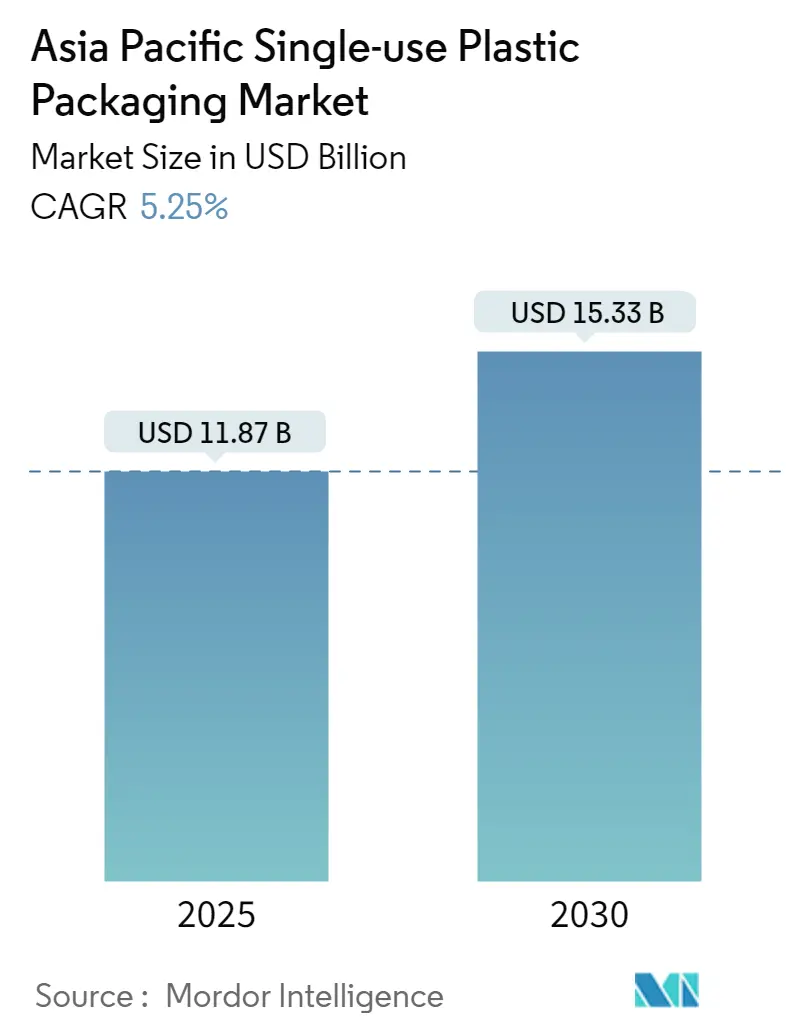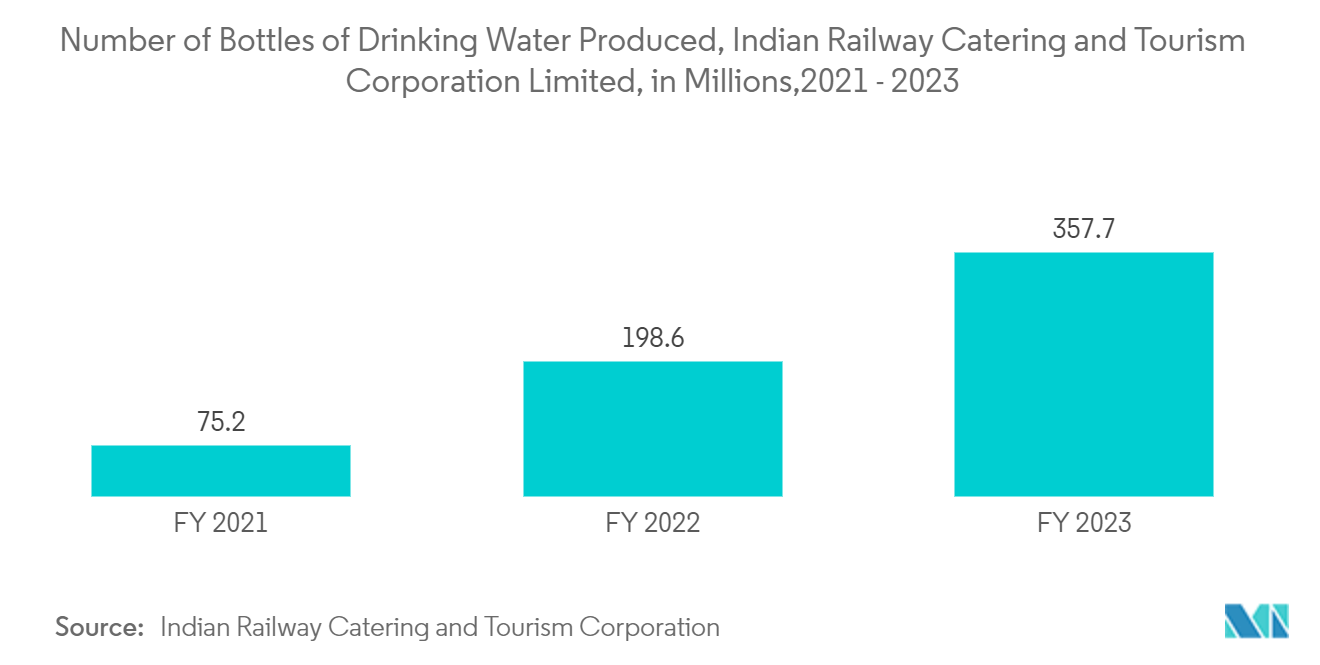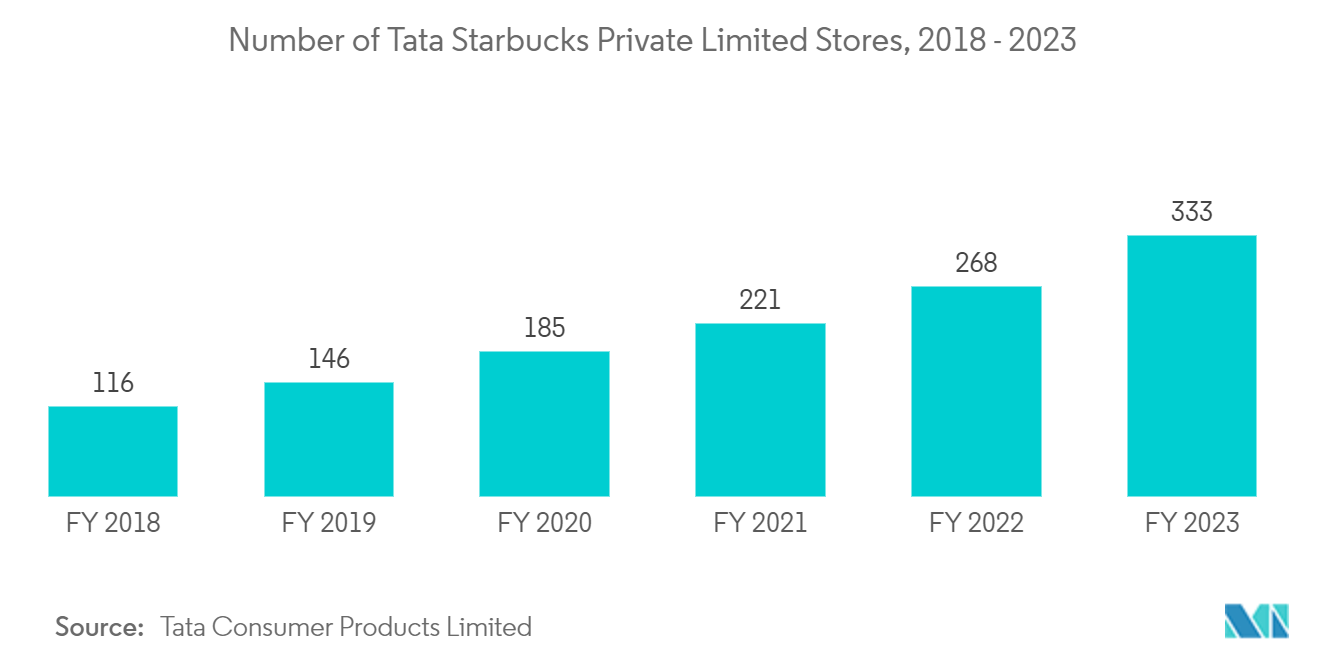Asia Pacific Single-use Plastic Packaging Market Size and Share

Asia Pacific Single-use Plastic Packaging Market Analysis by Mordor Intelligence
The Asia Pacific Single-use Plastic Packaging Market size is worth USD 11.87 Billion in 2025, growing at an 5.25% CAGR and is forecast to hit USD 15.33 Billion by 2030.
- Asia-Pacific, with its high population density and emerging economies like China and India, is witnessing a surge in the demand for food services. This demand is driven by the growing urban population and increasing disposable incomes, leading to a higher consumption of ready-to-eat and takeaway foods. Single-use plastic, driven by its convenience and cost-effectiveness, is poised to dominate the region's packaging landscape in the coming years. The versatility and durability of plastic make it an ideal choice for various packaging needs, from food containers to beverage bottles.
- Plastic, a longstanding staple in packaging, has supplanted traditional materials like corrugated paper boards, glass, and metals, primarily due to its economic advantages. Additionally, ongoing innovations in plastic packaging, such as biodegradable and recyclable options, bolster its popularity in the market.
- The region is a key investor and adopter in the single-use packaging market, driven by many end-user industries. Key growth drivers include a rising preference for packed meals, a surge in restaurant and supermarket numbers, and an escalating demand for bottled water and beverages. Additionally, the increasing urbanization and changing consumer lifestyles contribute to the demand for convenient and disposable packaging solutions. The region's robust economic growth and advancements in packaging technology further bolster the market's expansion. Moreover, stringent regulations on food safety and hygiene standards necessitate using single-use packaging, ensuring product integrity and consumer safety.
- The packaging industries in India and China have witnessed significant growth in recent years. This surge can be attributed to the establishment of numerous manufacturing units, innovative designs, and a heightened emphasis on research and development. Government programs like India's 'Make In India' further propel these advancements. The increased demand for sustainable, eco-friendly packaging solutions has also driven this growth. The rise of e-commerce and the need for efficient logistics necessitate the development of robust packaging solutions, thereby contributing to the market’s expansion. The collaboration between private companies and government bodies has fostered an environment conducive to innovation and growth in the packaging market.
- The region is grappling with a significant environmental threat due to the prevalent use of plastic materials. In response, governments and global regulatory bodies are taking decisive actions. For instance, India implemented a comprehensive ban on single-use plastic items deemed low utility and high littering potential. The prohibited list encompasses a wide array, from earbuds with plastic sticks to plastic flags, candy sticks, and even plastic cutlery. Additionally, items like plastic plates, cups, glasses, and even wrapping films around sweet boxes are included, with a strict size limit of under 100 microns.
- This regulatory move aims to mitigate the environmental impact caused by plastic waste, which often ends up in landfills or oceans, posing a threat to wildlife and ecosystems. By targeting items frequently discarded after a single use, the ban seeks to significantly reduce the volume of plastic waste. Moreover, the initiative encourages the adoption of sustainable alternatives, fostering innovation in the production of eco-friendly materials.
- Countries in the region are observing India's approach as a potential model for their own regulatory frameworks. The success of such bans could lead to broader international efforts to combat plastic pollution. In addition to legislative measures, public awareness campaigns are crucial in educating citizens about the environmental hazards of plastic waste and promoting responsible consumption behaviors.
Asia Pacific Single-use Plastic Packaging Market Trends and Insights
Bottles are Expected to Hold a Significant Market Share
- Once considered a luxury reserved for the affluent, bottled water has permeated even the most economically challenged regions. A clear sign of the expanding rural market is the emergence of water sales in affordable plastic pouches and small bottles. This surge in demand for compact water packaging underscores the nation's appetite for convenience. A decade ago, purchasing a 50 ml water bottle in these areas would have been deemed extravagant.
- The shift in consumer behavior highlights the increasing importance of accessibility and affordability in the bottled water market. Companies have adapted by offering smaller, more economical packaging options to cater to a broader audience. This trend reflects changing market dynamics and indicates a significant opportunity for growth in the packaged water sector. As more consumers in rural areas prioritize health and convenience, the demand for bottled water is expected to continue its upward trajectory.
- The plastic bottle industry, known for its versatility, stability, and affordability, finds applications across a spectrum of products. It encompasses high-density and low-density variants, serving as containers for various liquids, ranging from soft drinks to shampoos and cooking oils. The industry's adaptability allows it to cater to diverse market needs, including the packaging of beverages. Additionally, advancements in plastic manufacturing technologies have enhanced the durability and sustainability of plastic bottles, making them a preferred choice for both manufacturers and consumers. The ongoing innovations in recycling and biodegradable materials also contribute to the market’s growth, addressing environmental concerns and promoting eco-friendly practices.
- The rising popularity of plastic products has spurred the development of cost-effective and eco-friendly packaging solutions. Major players are introducing novel plastic product formats in response to the surging demand. These advancements in plastic bottle design, coupled with their cost-effectiveness, are fueling market expansion. The escalating preference for single-use plastic bottles is poised to drive further market growth, especially in Asia-Pacific. The region's growing population, urbanization, and increasing disposable income contribute to this trend. Additionally, the convenience offered by single-use plastic bottles aligns well with the fast-paced lifestyle of consumers in these countries, further bolstering market demand.
- In the competitive landscape of bottled water, manufacturers are turning to innovative packaging to stand out. This includes using transparent, sleek bottles, reusable materials, and even coatings on cans for enhanced visual appeal. Critical operations for bottled water firms involve water purification, bottling, and subsequent marketing and distribution. Their consumer base spans both institutional and retail sectors, covering a wide spectrum of on- and off-trade consumption.
- Retail customers can buy water from a range of retail and food service outlets. These include supermarkets, convenience stores, and cafes, where bottled water is readily available for individual purchase. In contrast, institutional buyers, such as restaurants, offices, and hotels, typically source their water from wholesale distributors. These wholesalers provide bulk quantities, ensuring a steady supply to meet the high demand of institutional clients.
- The Indian Railways is a significant player in the landscape of bottled water. As reported by the Indian Railway Catering and Tourism Corporation, in the fiscal year 2023, the Indian Railways Catering & Tourism Corporation Ltd. (IRCTC) not only consumed the most water bottles but also produced a staggering 357 million units. This marked a substantial increase of 75.2 million units from 2021. The IRCTC's production capacity highlights its critical role in both the supply and consumption of bottled water within the country.

Quick Service Restaurants are Expected to Hold a Significant Market Share
- The packaging market in China and India is at a crossroads, influenced by rising per capita incomes, evolving social landscapes, and shifting demographics. The market witnesses sporadic materials, processes, and design innovations driven by the need to meet consumer demand for convenience, sustainability, and enhanced product protection. As consumers become more health-conscious and environmentally aware, the market adapts by developing eco-friendly packaging solutions and incorporating advanced technologies to ensure food safety and extend shelf life.
- The dynamic nature of the market necessitates continuous adaptation and innovation, making packaging a critical component in the food and beverage industry’s growth and success. The fast-food industry in China has seen rapid growth in recent years, driven by a combination of factors such as urbanization, an increasing number of young consumers with sedentary lifestyles, and altered dietary preferences. The ongoing liberalization of the market in Beijing contributes to this growth, making it an attractive need for foreign investment.
- The surge in single-use plastic packaging finds impetus in the rising adoption of franchise models by leading restaurant chains and the expanding food and beverage sector. The convenience and cost-effectiveness of single-use plastic packaging make it an attractive option for these businesses. Moreover, the upswing in cafe culture and the proliferation of fast-food outlets, QSRs, and meal trucks further fuel this market's evolution. The increasing consumer demand for on-the-go meals and beverages also plays a significant role in driving the market. Additionally, advancements in packaging technology and materials enhance the functionality and sustainability of single-use plastic packaging, contributing to its widespread adoption.
- India's surging coffee consumption has spurred a proliferation of coffee outlets, with both domestic and international brands expanding their footprint. This growth is not only limited to the number of outlets but also extends to the variety of products offered. Companies are introducing a range of plastic cups and straws tailored to the diverse coffee preferences of Indian consumers. Starbucks, a prominent player in the coffee market, inaugurated its store in Mumbai in FY 2013. In FY 2022, the coffee giant boasted a network of 268 stores across India.
- Initially, Starbucks ventured into the Indian market through a 50:50 collaboration with Tata Consumer Products Limited, previously known as Tata Global Beverages Limited. Now operating as Tata Starbucks Private Limited, this joint venture has grown remarkably. By FY 2022, Starbucks had established its presence in 26 Indian cities. FY 2023 marked a significant expansion for the brand, with 71 new stores unveiled and a foray into 15 additional cities. This milestone represented Starbucks' most extensive annual store growth and elevated its total store count to 333, spanning 41 cities. The rapid expansion of Starbucks in India reflects the growing demand for premium coffee experiences and the increasing acceptance of global coffee culture among Indian consumers.

Competitive Landscape
The Asia-Pacific single-use packaging market is highly fragmented. Several global and regional players, such as Berry Global Inc., Amcor Group GmbH, Huhtamäki Oyj, and Hotpack Packaging Industries LLC, are vying for attention. This market is characterized by low product differentiation, growing levels of product penetration, and high levels of competition.
- August 2023: Amcor, a global player in developing and manufacturing sustainable packaging solutions, announced the acquisition of Phoenix Flexibles, adding capacity to the fast-growing Indian market. Phoenix Flexibles has a plant in Gujarat, India, and generates around USD 20 million in annual revenue from flexible packaging sales for applications such as food, home care, and personal care.
Asia Pacific Single-use Plastic Packaging Industry Leaders
Berry Global Inc
Amcor Group GmbH
Huhtamaki Oyj
Hotpack Packaging Industries LLC
Graphic Packaging International, LLC
- *Disclaimer: Major Players sorted in no particular order
.webp)
Recent Industry Developments
- April 2024: The Coca-Cola Company unveiled its latest sustainability initiative in Hong Kong, introducing 500 ml bottles crafted entirely from recycled plastic for its iconic soda. This move underscores the company's commitment to shrinking its environmental impact. In a groundbreaking step, the renowned beverage corporation transitioned all 500 ml bottles of Coca-Cola Original, Coca-Cola No Sugar, and Coca-Cola Plus in Hong Kong to be exclusively made from 100% recycled polyethylene terephthalate (rPET), marking a pioneering adoption of this material in China.
- October 2023: Coca-Cola India introduced a line of carbonated beverages in fully recycled PET bottles. The iconic Coca-Cola brand was made available in 100% recycled PET (rPET) bottles in 250 ml and 750 ml variants. Coca-Cola's bottling partners, Moon Beverages Ltd and SLMG Beverages Ltd, crafted these sustainable bottles.
Asia Pacific Single-use Plastic Packaging Market Report Scope
Single-use plastics, often also referred to as disposable plastics, are commonly used for plastic packaging and include items intended to be used once before they are thrown away or recycled. These include, among other things, grocery bags, food packaging, bottles, straws, containers, cups, and cutlery.
The Asia-Pacific single-use plastic packaging market is segmented by material (polylactic acid (PLA), polyethylene terephthalate (PET), polyethylene (PE), and other materials), product type (bottles, bags and pouches, clamshells, trays, cups, and lids, and other product types), end-user type (quick service restaurants, full service restaurants, institutional, retail, and other end users ), and country (China, Japan, India, South Korea, Australia and New Zealand, and the Rest of Asia-Pacific). The market sizes and forecasts are provided in terms of value (USD) for all the above segments.
| Polylactic Acid (PLA) |
| Polyethylene Terephthalate (PET) |
| Polyethylene (PE) |
| Other Types of Materials |
| Bottles |
| Bags & Pouches |
| Clamshells |
| Trays, Cups & Lids |
| Other Product Types |
| Quick Service Restaurants |
| Full Service Restaurants |
| Institutional |
| Retail |
| Other End-users |
| China |
| Japan |
| India |
| South Korea |
| Australia and New Zealand |
| By Material | Polylactic Acid (PLA) |
| Polyethylene Terephthalate (PET) | |
| Polyethylene (PE) | |
| Other Types of Materials | |
| By Product Type | Bottles |
| Bags & Pouches | |
| Clamshells | |
| Trays, Cups & Lids | |
| Other Product Types | |
| By End User | Quick Service Restaurants |
| Full Service Restaurants | |
| Institutional | |
| Retail | |
| Other End-users | |
| By Country*** | China |
| Japan | |
| India | |
| South Korea | |
| Australia and New Zealand |
Key Questions Answered in the Report
How big is the Asia Pacific Single-use Plastic Packaging Market?
The Asia Pacific Single-use Plastic Packaging Market size is worth USD 11.87 billion in 2025, growing at an 5.25% CAGR and is forecast to hit USD 15.33 billion by 2030.
What is the current Asia Pacific Single-use Plastic Packaging Market size?
In 2025, the Asia Pacific Single-use Plastic Packaging Market size is expected to reach USD 11.87 billion.
Who are the key players in Asia Pacific Single-use Plastic Packaging Market?
Berry Global Inc, Amcor Group GmbH, Huhtamaki Oyj, Hotpack Packaging Industries LLC and Graphic Packaging International, LLC are the major companies operating in the Asia Pacific Single-use Plastic Packaging Market.
What years does this Asia Pacific Single-use Plastic Packaging Market cover, and what was the market size in 2024?
In 2024, the Asia Pacific Single-use Plastic Packaging Market size was estimated at USD 11.25 billion. The report covers the Asia Pacific Single-use Plastic Packaging Market historical market size for years: 2019, 2020, 2021, 2022, 2023 and 2024. The report also forecasts the Asia Pacific Single-use Plastic Packaging Market size for years: 2025, 2026, 2027, 2028, 2029 and 2030.
Page last updated on:
Asia Pacific Single-use Plastic Packaging Market Report
Statistics for the 2025 Asia Pacific Single-use Plastic Packaging market share, size and revenue growth rate, created by Mordor Intelligence™ Industry Reports. Asia Pacific Single-use Plastic Packaging analysis includes a market forecast outlook for 2025 to 2030 and historical overview. Get a sample of this industry analysis as a free report PDF download.
.webp)


